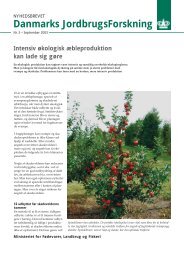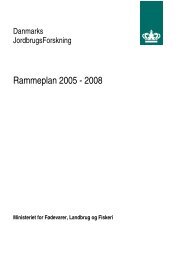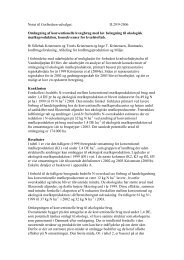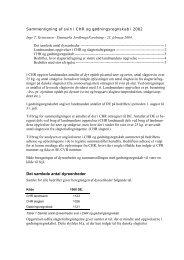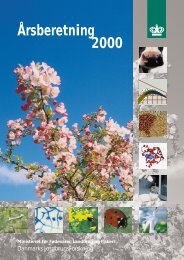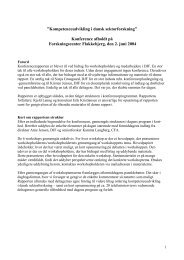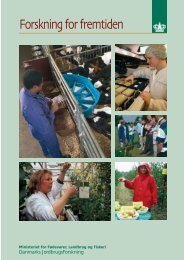Reproduction performances and conditions of group-housed non ...
Reproduction performances and conditions of group-housed non ...
Reproduction performances and conditions of group-housed non ...
You also want an ePaper? Increase the reach of your titles
YUMPU automatically turns print PDFs into web optimized ePapers that Google loves.
- Paper I -<br />
Gilts<br />
Moderate energy supply (29.4 MJ ME day -1 ) compared to low energy supply (17.6 MJ ME<br />
day -1 ) both from mating until 30/35 days after mating <strong>and</strong> from mating until ten days after<br />
mating increased the embryonic mortality <strong>and</strong> reduced the number <strong>of</strong> embryos in gilts<br />
(Dyck & Strain, 1983). Some authors argue that a lower embryo survival in gilts fed moderate<br />
energy intake could be due to the ovulation rate being increased <strong>and</strong> hence, the embryo<br />
mortality as a result <strong>of</strong> the moderate energy intake immediately after mating (Toplis et<br />
al., 1983). However, in the present study, the ovulation rate did not differ between the treatments.<br />
Therefore, this could probably not be the explanation. Jindal et al. (1996) also found<br />
that moderate energy supply in gilts the first 15 days after mating resulted in a significant<br />
lower embryo survival <strong>and</strong> a <strong>non</strong>-significant lower number <strong>of</strong> viable embryos at day 25-30<br />
compared to low energy supply. These authors also found an inverse relationship between<br />
plane <strong>of</strong> nutrition <strong>and</strong> circulating progesterone concentrations. Furthermore they observed<br />
that the <strong>group</strong> <strong>of</strong> gilts with the greatest average plasma progesterone concentration had the<br />
greatest embryonal survival. Similarly, Pharazyn et al. (1991) observed that overall plasma<br />
progesterone concentrations on day three after oestrus were positively related to embryo<br />
survival. Perhaps increases in energy intake leading to rapid gains will result in reduced<br />
embryo survival because <strong>of</strong> an increase in metabolic clearance <strong>of</strong> progesterone as a<br />
consequence <strong>of</strong> increased hepatic blood flow (Einarsson & Rojkittikhun, 1993)<br />
Reduced levels <strong>of</strong> energy from day three to day 15 <strong>of</strong> gestation did not have an effect on the<br />
number <strong>of</strong> embryos in the uterus at day 28 (Pharazyn et al., 1991). Similarly, Jindal et al.<br />
(1996) found that low energy supply from day three after mating until day 15 does not effect<br />
embryo survival. Therefore, these authors suggest that a reduction in feed intake has a<br />
positive effect but only if it occurs in the first days after onset <strong>of</strong> oestrus. This is in agreement<br />
with other studies beginning treatment three days after mating <strong>and</strong> finding no effect<br />
(Liao & Veum, 1994) or even a negative effect (Liao & Veum, 1994) <strong>of</strong> low compared to<br />
moderate energy supply.<br />
In the light <strong>of</strong> the above-mentioned results, it seems that a low feed intake (17.6/22.8 MJ<br />
ME day -1 ) the first days after mating has a positive effect on reproduction performance<br />
compared to moderate feed intake (29.4/31.3 MJ ME day -1 ). However, in other studies with<br />
treatment beginning immediately after mating, no positive effect <strong>of</strong> low energy supply<br />
(15.7/21.4 MJ ME day -1 ) was found compared to moderate energy supply (31.4/34.6 MJ<br />
ME day -1 ) on embryo survival (Dyck, 1991; Cassar & King, 1992) or number <strong>of</strong> foetuses<br />
(Dyck, 1991). So, the results are inconsistent. Foxcr<strong>of</strong>t (1997) argues that the inconsistency<br />
in much <strong>of</strong> the literature regarding effect <strong>of</strong> energy intake on embryo survival could be due<br />
to differences in number <strong>of</strong> animals used <strong>and</strong> level <strong>of</strong> embryo survival in the control <strong>group</strong>.<br />
32




